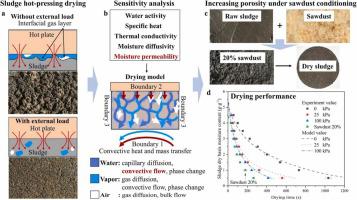当前位置:
X-MOL 学术
›
Process Saf. Environ. Prot.
›
论文详情
Our official English website, www.x-mol.net, welcomes your feedback! (Note: you will need to create a separate account there.)
Enhancing sludge hot-pressing drying by sawdust: Sensitivity analysis of heat and mass transfer physical properties of sludge, process performance, and kinetics
Process Safety and Environmental Protection ( IF 6.9 ) Pub Date : 2024-06-15 , DOI: 10.1016/j.psep.2024.06.037 Dexiao Ma , Shuo Cheng , Guozhao Ji , Aimin Li
Process Safety and Environmental Protection ( IF 6.9 ) Pub Date : 2024-06-15 , DOI: 10.1016/j.psep.2024.06.037 Dexiao Ma , Shuo Cheng , Guozhao Ji , Aimin Li

|
Hot-pressing drying shows promise in sludge treatment. Optimization often focuses on temperature and external load. However, the impact is restricted by sludge inherent properties, which can be changed by sludge conditioning. Due to coupling effects, altering individual sludge properties is difficult. Key sludge properties that significantly affect heat and mass transfer remain unclear, hampering identification of specific conditioning techniques. To address this gap, the effects of sludge specific heat, thermal conductivity, water activity, moisture diffusivity, and moisture permeability on drying performance were explored using sensitivity analysis. Sawdust conditioning and kinetics were employed to improve drying performance, validate sensitivity analysis findings, and elucidate drying mechanisms. Sensitivity analysis revealed that liquid water permeability significantly positively influenced drying performance by enhancing liquid water convection. Sawdust conditioning and kinetics demonstrated that adding 20 % sawdust increased drying flux from 31 to 62 kg·m⁻²·h⁻¹. The drying process included warm-up and constant rate, the first falling rate, and the second falling rate periods. Enhanced moisture transfer was dominated by breakthrough of interfacial gas film, transformation from liquid water diffusion to convection, and facilitated water vapor diffusion, respectively. Hence, this study provided novel insights, strategies, and direction of guidance for revealing sludge drying mechanisms and improving drying performance.
中文翻译:

木屑强化污泥热压干燥:污泥传热传质物理性质、工艺性能和动力学的敏感性分析
热压干燥在污泥处理中显示出前景。优化通常侧重于温度和外部负载。然而,其影响受到污泥固有特性的限制,而污泥固有特性可以通过污泥调理来改变。由于耦合效应,改变单个污泥的特性是很困难的。显着影响传热传质的关键污泥特性仍不清楚,这阻碍了特定调节技术的识别。为了解决这一差距,利用敏感性分析探讨了污泥比热、导热系数、水分活度、水分扩散率和水分渗透率对干燥性能的影响。采用木屑调节和动力学来提高干燥性能、验证敏感性分析结果并阐明干燥机制。敏感性分析表明,液态水渗透性通过增强液态水对流对干燥性能产生显着的积极影响。锯末调节和动力学表明,添加 20% 锯末可将干燥通量从 31kg·m^2·h^1 增加到 62kg·m^^h^-1。干燥过程包括预热和恒速、第一次降速和第二次降速阶段。增强的水分传递分别通过界面气膜的突破、从液态水扩散到对流的转变以及促进水蒸气扩散来主导。因此,本研究为揭示污泥干燥机理和提高干燥性能提供了新的见解、策略和指导方向。
更新日期:2024-06-15
中文翻译:

木屑强化污泥热压干燥:污泥传热传质物理性质、工艺性能和动力学的敏感性分析
热压干燥在污泥处理中显示出前景。优化通常侧重于温度和外部负载。然而,其影响受到污泥固有特性的限制,而污泥固有特性可以通过污泥调理来改变。由于耦合效应,改变单个污泥的特性是很困难的。显着影响传热传质的关键污泥特性仍不清楚,这阻碍了特定调节技术的识别。为了解决这一差距,利用敏感性分析探讨了污泥比热、导热系数、水分活度、水分扩散率和水分渗透率对干燥性能的影响。采用木屑调节和动力学来提高干燥性能、验证敏感性分析结果并阐明干燥机制。敏感性分析表明,液态水渗透性通过增强液态水对流对干燥性能产生显着的积极影响。锯末调节和动力学表明,添加 20% 锯末可将干燥通量从 31kg·m^2·h^1 增加到 62kg·m^^h^-1。干燥过程包括预热和恒速、第一次降速和第二次降速阶段。增强的水分传递分别通过界面气膜的突破、从液态水扩散到对流的转变以及促进水蒸气扩散来主导。因此,本研究为揭示污泥干燥机理和提高干燥性能提供了新的见解、策略和指导方向。











































 京公网安备 11010802027423号
京公网安备 11010802027423号